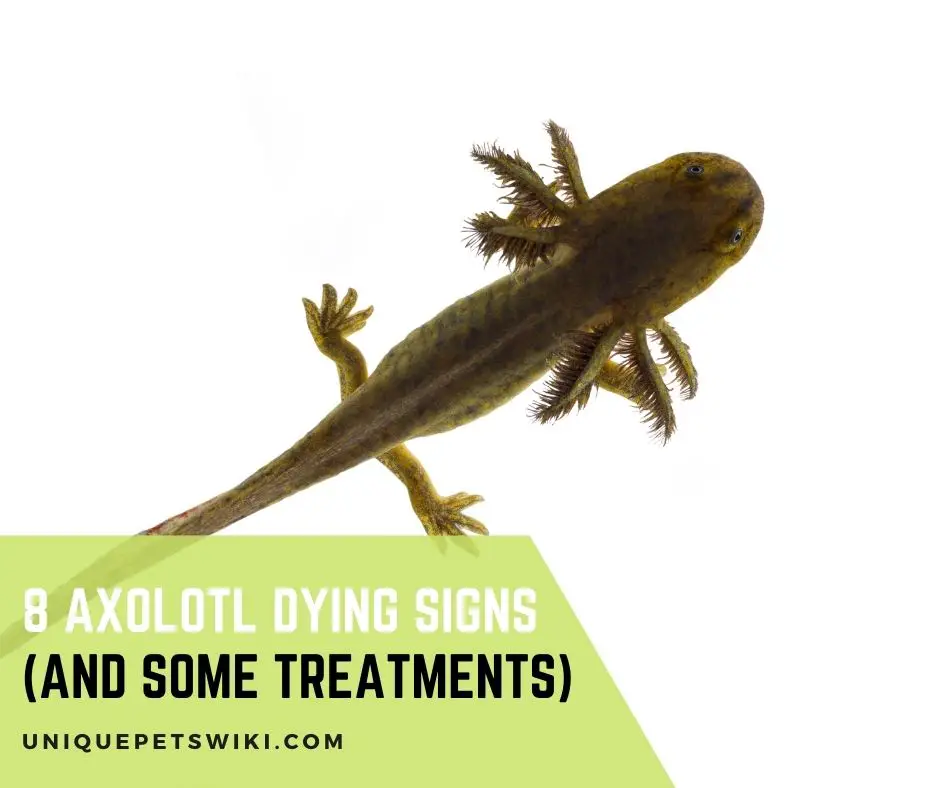Although axolotls are hardy creatures, they can develop health problems even if you house them in an ideal environment.
However, it is the responsibility of every axolotl owner to give their axolotl a happy and healthy life. You should know when they are healthy or sick.
The best thing about axolotls is that you can quickly tell when something is wrong with them.
A sick axolotl will display several signs such as refusing to eat, shedding slime coat, swimming upside down, gills falling off, etc.
However, axolotls can display similar signs for different health problems.
This is why we have created this article to help you highlight different axolotl dying signs, what it means, and what you can do.
Contents
8 Axolotl Dying Signs
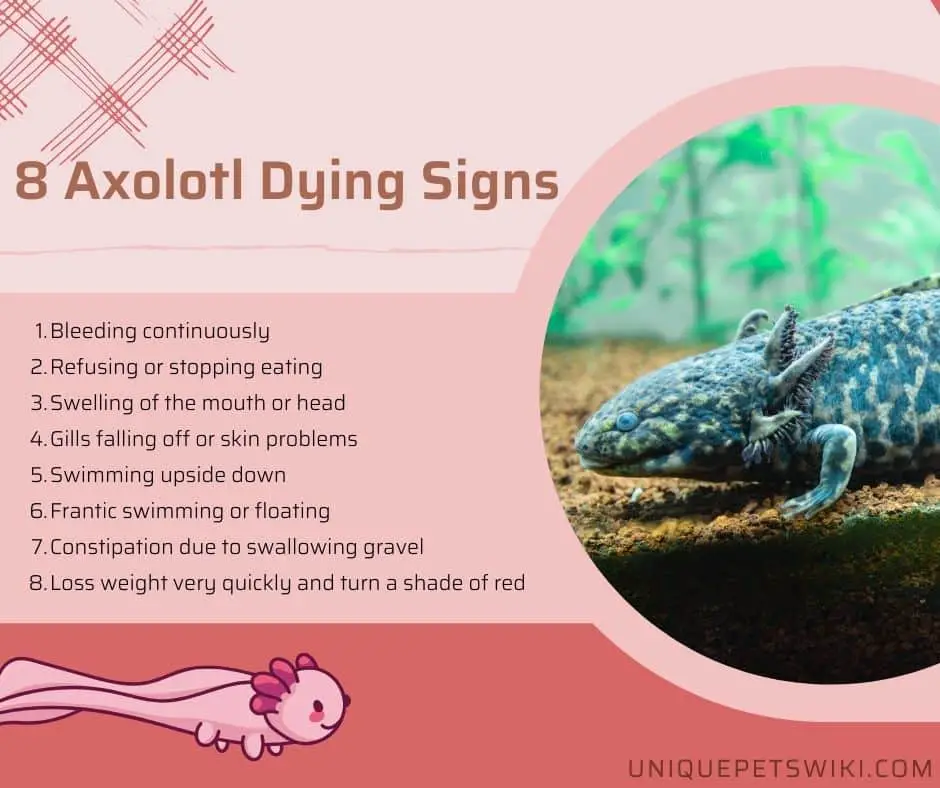
Axolotls require special care to keep them happy and healthy. This is because they can get sick if you don’t provide special care.
Some of the things that can get an axolotl sick are water quality, tank mates, environment, temperature, etc.
Here are some dying signs that an axolotl can give when it is suffering from a health problem:
- bleeding continuously
- refusing or stopping eating
- loss weight very quickly and turn a shade of red
- swelling of the mouth or head
- gills falling off or skin problems
- swimming upside down
- frantic swimming or floating
- constipation due to swallowing gravel
Bleeding Continuously
There are times when your axolotl can get sick because of the injury or wound in different parts of their body.
Your axolotl can get injured if you place sharp edges in the rocks or wood in their tank. Your axolotl can also get injured if you house them with aggressive tank mates.
Parasites can also cause localized bleeding in the axolotl. Axolotl scar can get infected by bacteria if you don’t treat it.
Once you find blood in your axolotl tank, you should try to check your axolotl body parts like gills, fins, or feet for cuts.
This will help to determine whether your axolotl is badly injured or not. Axolotls with minor injuries can easily regenerate without receiving treatment.
All you must do is provide clean water to help ensure the scar does not get infected.
However, if you notice that some parts of your axolotl body are bleeding continuously, then this indicates that your axolotl is badly injured or has internal injuries.
This can be fatal if left unchecked, and you should contact your vet for a diagnosis.
Refusing or Stopping Eating (Loss of Appetite)
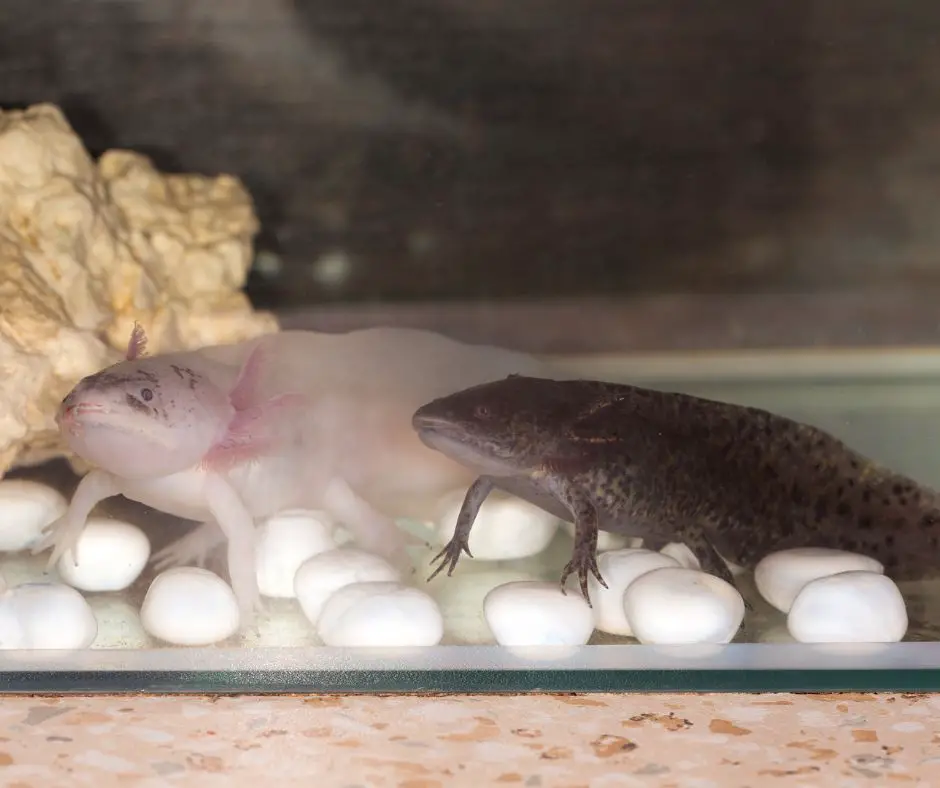
One of the common signs that an axolotl can give when dying is to refuse or stop eating.
You may also notice that your axolotl eats less than they usually do or even vomit the food that they eat. Some of the common reasons why axolotl can stop eating are:
- Excess stress
- High temperature
- Bad water quality, etc.
- Due to overfeeding.
When an axolotl stops eating, the first thing to do is to determine what caused the issue to help know the best way to treat it.
You can avoid feeding your axolotl for a few days and check what happens if your axolotl is not eating because of overfeeding.
You should also check the water quality in your axolotl tank regularly and make adjustments when necessary if the water quality is not ideal.
Also read: Why Is My Axolotl Not Eating?
Lose Weight Very Quickly and Turn Shade of Red
Your axolotl can lose weight very quickly if it is sick or not getting enough food. The best thing to do is determine the cause of the issue before you can treat this.
However, when monitoring your axolotl for symptoms, you can try and feed them moderately to see if their appetite can return.
Axolotls can turn red if they have a bacterial infection known as ‘red leg’ bacteria or have ammonia burn.
You will notice that your axolotl skin becomes red and inflamed, and your axolotl can even scratch the inflamed parts on the aquarium wall.
You can deal with this problem by ensuring you do a proper water cycling of your axolotl tank. You can also consult with the vet for a suitable treatment in case bacteria infect your axolotl.
Swelling Of The Mouth or Head
Swelling of the mouth or head is another popular sign that axolotl can give when suffering from a health problem.
Swelling of the limbs, head, mouth, or neck can indicate that your axolotl is infected. Many axolotl owners also refer to this symptom as fluid retention.
This infection can become fatal and lead to death if not treated immediately. It is recommended that you take your axolotl to the vet for a consultation immediately.
Gills Falling Off or Skin Problems
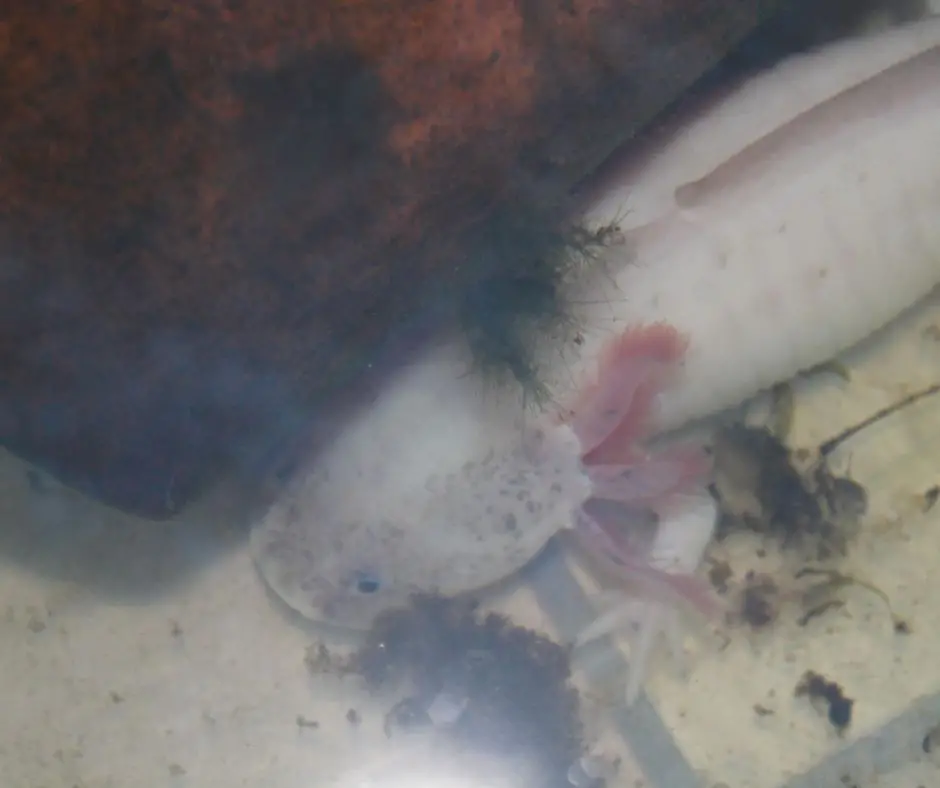
You can also determine if an axolotl is sick, if its gill falls off, or has a skin problem.
This usually happens if you house your axolotl in an aquarium with poor water quality, stress due to strong water flow, or bacterial or fungal infection.
You could give your axolotl a salt bath if this happens because of infection, especially fungal infection.
It is also important that you check the water quality in the enclosure to ensure it is at an ideal range if your axolotl is shedding slime coat or is stressed.
You should also check the water flow from the filter and try to reduce it if it is too strong.
Also read: Axolotl Shedding Slime Coat: 4 Common Causes and How to Prevent
Swimming Upside Down
Axolotls can also swim upside down whenever they are sick. However, this usually indicates that your axolotl suffers from a severe issue that can lead to death if not treated.
Some of the reasons why an axolotl can swim upside down are:
- Severe overfeeding
- High toxicity level.
- Severe infection.
- Impaction
Once you notice this, the best thing you can do is move the axolotl to a spare tank with the appropriate water quality. You can also try to put your axolotl in a fridge if this is caused by impaction.
Also read: Full Requirements & Water Conditions for Axolotl in Captivity
Frantic Swimming or Floating
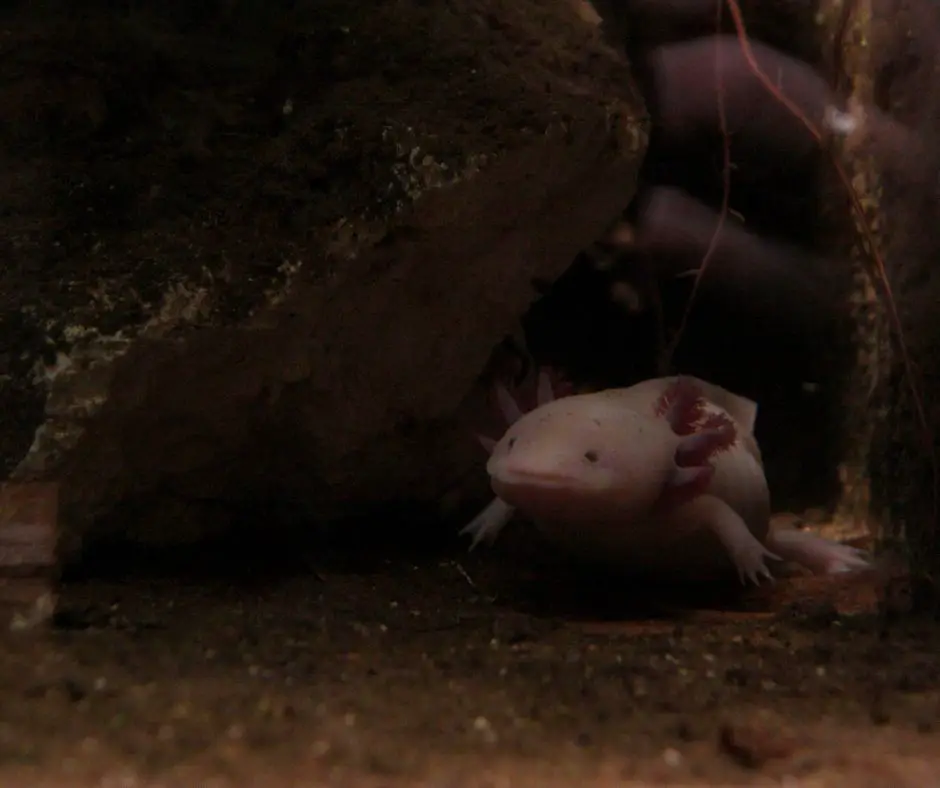
Generally, axolotls are ground-dwelling creatures but can float or swim frantically when suffering from a health problem. Some of the reasons why an axolotl can float in water are:
- They are impacted
- They swallow bubble
- Bad water quality
- Excess ammonia in their tank, etc.
You can scare your axolotl, and it will swim to the bottom if it swallows the bubbles or plays dead. However, you will need to refrigerate your axolotl if it is impacted.
It is also important that you check the water quality in your axolotl tank, as this can happen if there is excess ammonia and nitrite in their aquarium.
Also read: Why Is My Axolotl Floating?
Constipation Due to Swallowing Gravel
Axolotls can also die if it is constipated. Constipation in axolotl can occur if you overfeed them if they swallow gravel or gas buildup in their body.
You can easily treat constipation by waiting for a few days without feeding your axolotl. However, if constipation is caused by impaction, you can try to refrigerate your axolotl until the impaction clears.
Note:
An uncommon but serious sign of death in axolotl is morphing. This is rare in nature, the so problem can be your husbandry, specifically what you feed it.
Scientifically speaking, axolotls can be stimulated to metamorphose by injecting them with iodine or feeding them iodine-rich foods.
Injecting or consuming iodine boosts the production of thyroid hormones that allow the axolotl to undergo metamorphosis. Most morphing axolotls are very painful/harmful and most axolotls do not survive. Here are some of the changes:
- The limbs become more muscular and stronger.
- fins are absorbed by the body
- The tail becomes rounded.
- Eyes bulge and eyelids develop.
- Round head. Changes in skin texture/color.
So, if you notice any sign of morphing, you must also assist the axies through this stage even though the survival rate is very low.
What Causes Axolotl to Die?
Axolotls are living things and can die naturally even under optimal care. Apart from natural death, axolotls can also die due to several reasons and health problems.
Some of the things that can lead to the death of an axolotl are stated below.
- Wrong water temperature.
- The buildup of ammonia and nitrite
- Your axolotl swallowed gravel
- Parasite or fungal infection
- Poor water quality
- Feeding axolotl with infected food.
- Stress
- can turn into salamander
Also read: Axolotl Temperature (Tips to Maintain an Ideal Temperature)
API Water Test Kit
- Contains one (1) API FRESHWATER MASTER TEST KIT 800-Test Freshwater Aquarium Water Master Test Kit, including 7 bottles of testing solutions, 1 color card and 4 glass tubes with cap
- Helps monitor water quality and prevent invisible water problems that can be harmful to fish and cause fish loss
- Accurately monitors 5 most vital water parameters levels in freshwater aquariums: pH, high range pH, ammonia, nitrite, nitrate
- Designed for use in freshwater aquariums only
- Use for weekly monitoring and when water or fish problems appear
Last update on 2022-12-30 / Affiliate links / Images from Amazon Product Advertising API
How to Save A Dying Axolotl
Mortality and disease progression are directly related to age, health status, and etiology. Baby axolotls have a higher mortality rate than adult axies. It is important that you act fast. Before you can save a dying axolotl, you need first to know the cause of their sickness.
However, when determining the cause of their sickness, you should avoid mishandling them as this can be fatal to your axolotl.
Furthermore, it is recommended not to hold your axolotls directly to avoid hurting them.
The best thing you can do is first to quarantine the dying axolotl while determining the cause of the problem. Some of the ways to save a dying axolotl are stated below.
Quarantine
Once you notice that something is wrong with your axolotl, the first thing to do is to isolate and quarantine it in another tank, especially if you have multiple axolotls.
Here are steps to follow when setting up a quarantine tank for your axolotl.
- Use a tank or tub that is very deep or has a cover to help prevent your axolotls from jumping out of the quarantine tank.
- You first need to dechlorinate the water you want to use for the quarantine tank before adding your axolotls.
- Ensure the water is at the ideal temperature.
- Use a cloth to cover the tank to help prevent exposing your axolotl to too much light.
- Ensure you change the water daily.
Take Water Toxicity Levels
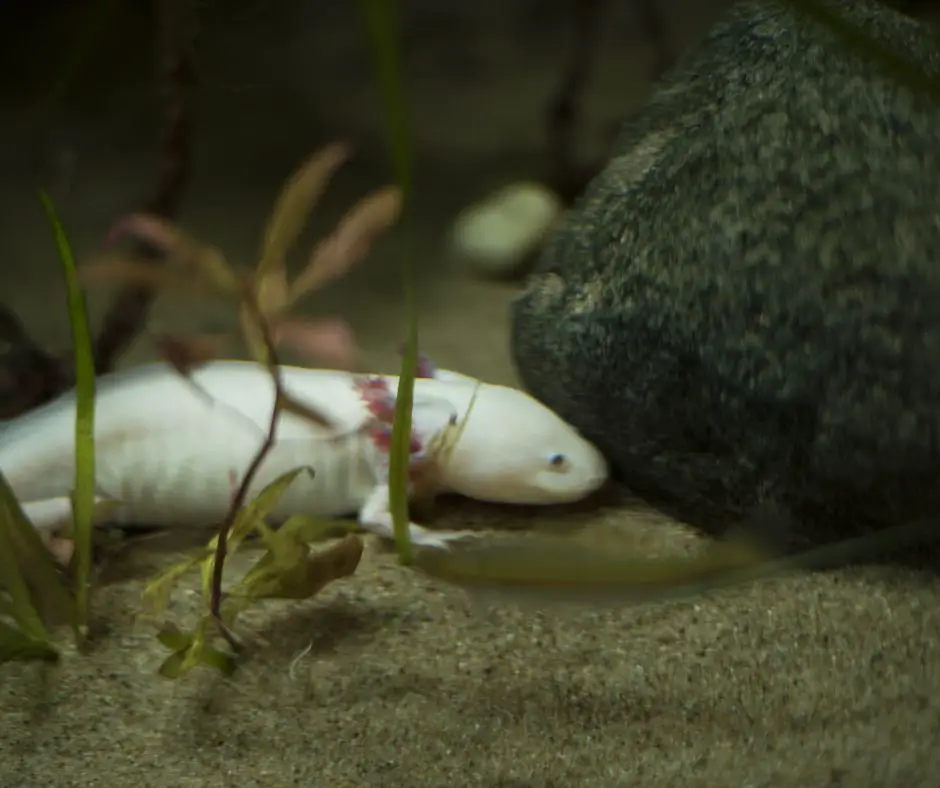
It is recommended that you test your aquarium’s water at least once a week to help ensure the water is safe for your axolotl.
You can use the Freshwater Master Test Kit by API to test your axolotl’s water quality.
However, if you don’t know how to take the measurement, you can take your water sample in a clean container to the local fish store for testing.
Here is a breakdown of the ideal water requirement for an axolotl to thrive well.
- Acceptable and Ideal pH Level: 6.5-8.0 and 7.4-7.6, respectively.
- Nitrate: less than 40ppm.
- Nitrites: 0ppm
- Ammonia: 0ppm
- Temperature: 16-18C or 60-64F.
You can then adjust the water quality parameter to a suitable level if your reading is not at the ideal range.
See A Vet
It is recommended that you don’t treat a sick axolotl carelessly if you don’t know the cause of their sickness.
This means you need to consult with your vet if you have monitored your axolotl and cannot determine the cause of the problem.
The vet will then help examine your axolotl and provide the best way to treat your axolotl.
Monitor Symptoms
You should try to monitor your axolotl symptoms closely in their quarantine tank. Your axolotl may receive treatment if the health problem is minor or caused by water quality.
You can monitor your axolotl in the quarantine tank for 2-3 days if it has bent gills or tail. Then determine if their appetite returns by feeding them every two days.
However, you will need to immediately give your axolotl a salt bath if it is suffering from a skin-related issue.
Also read: How To Give Axolotl Salt Bath
Examining Your Tank Environment
After quarantining your axolotl, you can also check your axolotl aquarium for the following items:
- Sharp or jagged decorations: Axolotls have poor eyesight and may accidentally swim into the sharp objects in their tank and hurt themselves.
- Gravel or small rocks: Axolotl may accidentally ingest gravel or small rocks causing impaction. It is best that you avoid using gravel or small rocks smaller than your axolotl’s head to help prevent this.
- Unsafe dyes: dyes can be found on the sand and décor used for your axolotl aquarium. Whenever you are buying a product for your axolotl, you need to ensure that you check the label and see if it is safe for your axolotl.
- Aggressive tankmates: Some tank mates like tetras, guppies, and even axolotl may nip at your axolotl’s gills and tails. This is why you need to ensure plenty of room in your aquarium whenever you are keeping multiple pets in the same aquarium. They also need to be well fed to help avoid this issue.
Also read: 6 Best Axolotl Tank Mates
What to Do With a Dead Axolotl?
Although axolotl can regenerate their bodies, they cannot return to life after death. If you notice that your axolotl is dead, the first thing to do is to remove them from the tank.
This is because a dead axolotl can quickly make the water dirty, which affects the other tank mates.
It is then recommended that you replace the water in the tank or even move the remaining axolotl to a temporary aquarium until the water quality is back to normal.
You can then wrap the dead axolotl in a plastic bag and dispose of it or bury it in your yard. We know it’s not easy, we all have a great time with our pets.
So, consider burying them, which can both protect the environment and also be a place of memories.
Aqueon Aquarium Starter Kit with LED Lighting 10
- All the equipment needed to get started in one box!
- Low profile full hood contains vibrant cool white LED lighting to bring your aquatic environment to life
- Filter has a red LED light that flashes to indicate when it’s time to change the cartridge
- Simply add your favorite style of plants and decor
- Preset heater will keep your aquarium temperature at a constant 78 degrees, appropriate for most tropical fish
Last update on 2022-12-30 / Affiliate links / Images from Amazon Product Advertising API
FAQs
Do axolotls float when they are dead?
A dead axolotl will first sink to the tank bottom with its tail curled. The dead axolotl’s body will then float after 1-2 days and smell because the body will start to decay.
Also read: Why Are My Axolotls’ Tails Curled?
How do I know if my axolotl is stressed?
There are several signs that an axolotl can give whenever they are stressed. Some of them are:
Curled tail tip
Curled gills and gill deterioration
Loss of appetite
A frequent gulp of air
Lack of responsiveness
Frantic swimming
Floating
Loss of color in gills and/or body.
Also read: 10 Axolotl Stress Signs
Final Words
It is important to keep your axolotls healthy if you want them to reach their life expectancy.
However, several things can make your axolotl sick, such as high temperature, poor water quality, wound, fungal or bacterial infection, stress, wrong diet, etc.
Once you notice that your axolotl is sick, the best thing to do is determine the cause of the disease to help treat it.
We hope your axolotl will get back to its healthy state if you follow some of the tips in this article.
